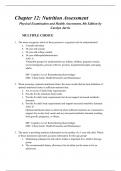Tentamen (uitwerkingen)
Chapter 12: Nutrition Assessment Physical Examination and Health Assessment, 8th Edition by Carolyn Jarvis
- Instelling
- Physical Examination And Health Assessment
Physical Examination and Health Assessment, 8th Edition by Carolyn Jarvis MULTIPLE CHOICE 1. The nurse recognizes which of these persons is at greatest risk for undernutrition? a. 5-month-old infant b. 50-year-old woman c. 20-year-old college student d. 30-year-oldhospitaladministrator...
[Meer zien]




